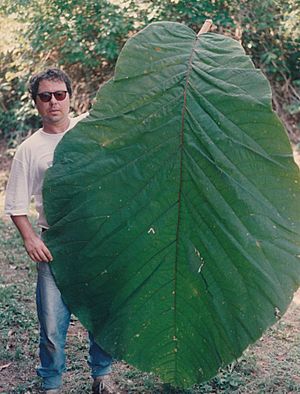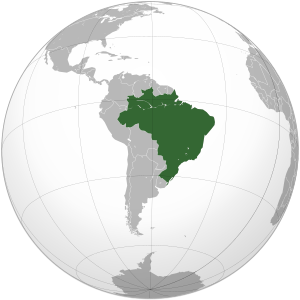Coccoloba gigantifolia facts for kids
Quick facts for kids Coccoloba gigantifolia |
|
|---|---|
 |
|
| Single leaf overtowering an adult man and illustrating its enormous size | |
| Scientific classification | |
| Genus: |
Coccoloba
|
| Species: |
gigantifolia
|
 |
|
| Distribution of Coccoloba gigantifolia (North Brazil) | |
Coccoloba gigantifolia is a super cool flowering plant that belongs to the knotweed family, called Polygonaceae. It's found only in a special part of Brazil, near the Madeira River Basin. You can find it in the states of Amazonas and Rondonia in the central and southwestern Brazilian Amazon. This plant is a bit like another species called Coccoloba mollis, but its leaves are way, way bigger, especially on its fertile branches!
Meet the Giant Leaf Tree!
Coccoloba gigantifolia is a tree that can grow as tall as 49 feet (15 meters), which is like a five-story building! But the most amazing thing about it is its leaves. They can be up to 8 feet (2.4 meters) long and 4 ft 7 in (1.40 meters) wide. Imagine a leaf bigger than you! This makes it one of the largest leaves among plants that have two seed leaves (called dicotyledonous plants), right after the giant rhubarb and the Bolivian water lily.
The stem that holds the leaf, called the petiole, is only about four inches (10 centimeters) long and one inch (2.5 cm) thick. Besides its huge leaves, you can tell this tree apart from its relatives by its straight trunk, which is usually not much thicker than three inches (7.6 centimeters). It also has rings around its trunk and a special jointed petiole that connects to a sheath at the base of its leaves. The whole plant is a bit fuzzy, and its branches have a hollow center. These giant leaves grow in a circle at the top of the main trunk and on its few branches. It seems this tree doesn't have a local name from the people who live there.
The Discovery Story
Botanists first saw this plant in 1982 during an expedition on the Canumã River, which flows into the Madeira River. They knew it was special, but they couldn't collect a sample because it didn't have any flowers or fruits.
Then, in 1986, another trip led by botanist Juan Revilla found a very large-leaved Coccoloba near Porto Velho city. They took a photo, but again, they couldn't collect a specimen for a plant collection (called a herbarium) because it wasn't ready.
Between 1989 and 1993, about 14 more of these trees were found in the Jamari National Forest Reserve. They collected some of the huge leaves, even though the trees still weren't producing flowers or fruits. In 1995, Silvestre Silva photographed more of these large-leaved Coccoloba trees near Autazes, about 110 km southeast of Manaus.
Finally, in August 2005, an expedition near the Jamari Forest Reserve found what they needed! They collected samples of its flowers, along with fallen ripe fruits and seeds from under one of the trees. This was a big moment because it allowed them to officially describe and name this amazing new species!
What's in a Name?
The scientific name gigantifolia is a perfect fit for this tree! It comes from the words "gigantic" and "folia," which means "leaf." So, gigantifolia simply means "giant-leaved," referring to the plant's unusually large leaves.
See also
 In Spanish: Coccoloba gigantifolia para niños
In Spanish: Coccoloba gigantifolia para niños

